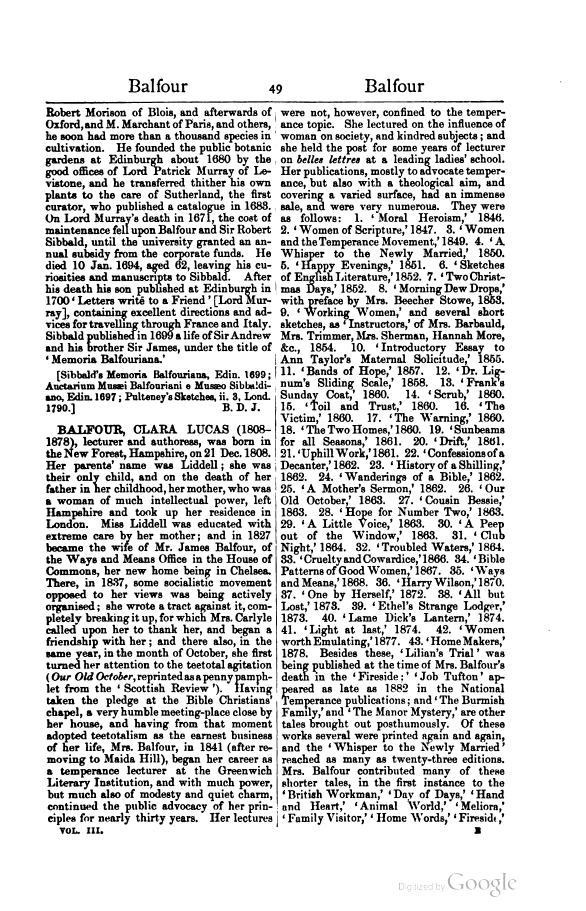Robert Morison of Blois, and afterwards of Oxford, and M. Merchant of Paris, and others, he soon had more than a thousand species in cultivation. He founded the public botanic gardens at Edinburgh about 1680 by the good offices of Lord Patrick Murray of Levistone, and he transferred thither his own plants to the care of Sutherland, the first curator, who published a catalogue in 1683. On Lord Murray's death in 1671, the cost of maintenance fell upon Balfour and Sir Robert Sibbald, until the university granted an annual subsidy from the corporate funds. He died 10 Jan. 1694, aged 62, leaving his curiosities and manuscripts to Sibbald. After his death his son published at Edinburgh in 1700 'Letters writé to a Friend' [Lord Murray], containing excellent directions and advices for travelling through France and Italy. Sibbald published in 1699 a life of Sir Andrew and his brother Sir James, under the title of 'Memoria Balfouriana.'
[Sibbald's Memoria Balfouriana, Edin. 1699; Auctarium Musei Balfouriani e Museo Sibbaldiano, Edin. 1697; Pulteney's Sketches, ii. 3, Lond. 1790.]
BALFOUR, CLARA LUCAS (1808–1878), lecturer and authoress, was born in the New Forest, Hampshire, on 21 Dec. 1808. Her parents' name was Liddell; she was their only child, and on the death of her father in her childhood, her mother, who was a woman of much intellectual power, left Hampshire and took up her residence in London. Miss Liddell was educated with extreme care by her mother; and in 1827 became the wife of Mr. James Balfour, of the Ways and Means Office in the House of Commons, her new home being in Chelsea. There, in 1837, some socialistic movement opposed to her views was being actively organised; she wrote a tract against it, completely breaking it up, for which Mrs. Carlyle called upon her to thank her, and began a friendship with her; and there also, in the same year, in the month of October, she first turned her attention to the teetotal agitation (Our Old October, reprinted as a penny pamphlet from the 'Scottish Review'). Having taken the pledge at the Bible Christians' chapel, a very humble meeting-place close by her house, and having from that moment adopted teetotalism as the earnest business of her life, Mrs. Balfour, in 1841 (after removing to Maida Hill), began her career as a temperance lecturer at the Greenwich Literary Institution, and with much power, but much also of modesty and quiet charm, continued the public advocacy of her principles for nearly thirty years. Her lectures were not, however, confined to the temperance topic. She lectured on the influence of woman on society, and kindred subjects ; and she held the post for some years of lecturer on belles lettres at a leading ladies' school. Her publications, mostly to advocate temperance, but also with a theological aim, and covering a varied surface, had an immense sale, and were very numerous. They were as follows:
- 'Moral Heroism,' 1846.
- 'Women of Scripture,' 1847.
- 'Women and the Temperance Movement,' 1849.
- 'A Whisper to the Newly Married,' 1850.
- 'Happy Evenings,' 1851.
- 'Sketches of English Literature,' 1852.
- 'Two Christmas Days,' 1852.
- 'Morning Dew Drops,' with preface by Mrs. Beecher Stowe, 1853.
- 'Working Women,' and several short sketches, as 'Instructors,' of Mrs. Barbauld, Mrs. Trimmer, Mrs. Sherman, Hannah More, &c., 1854.
- 'Introductory Essay to Ann Taylor's Maternal Solicitude,' 1855.
- 'Bands of Hope,' 1857.
- 'Dr. Lignum's Sliding Scale,' 1858.
- 'Frank's Sunday Coat,' 1860.
- 'Scrub,' 1860.
- 'Toil and Trust,' 1860.
- 'The Victim,' 1860.
- 'The Warning,' 1860.
- 'The Two Homes,' 1860.
- 'Sunbeams for all Seasons,' 1861.
- 'Drift,' 1861.
- 'Uphill Work,' 1861.
- 'Confessions of a Decanter,' 1862.
- 'History of a Shilling,' 1862.
- 'Wanderings of a Bible,' 1862.
- 'A Mother's Sermon,' 1862.
- 'Our Old October,' 1863.
- 'Cousin Bessie,' 1863.
- 'Hope for Number Two,' 1863.
- 'A Little Voice,' 1863.
- 'A Peep out of the Window,' 1863.
- 'Club Night,' 1864.
- 'Troubled Waters,' 1864.
- 'Cruelty and Cowardice,' 1866.
- 'Bible Patterns of Good Women,' 1867.
- 'Ways and Means,' 1868.
- 'Harry Wilson,' 1870.
- 'One by Herself,' 1872.
- 'All but Lost,' 1873.
- 'Ethel's Strange Lodger,' 1873.
- 'Lame Dick's Lantern,' 1874.
- 'Light at last,' 1874.
- 'Women worth Emulating,' 1877.
- 'Home Makers,' 1878.
Besides these, 'Lilian's Trial' was being published at the time of Mrs. Balfour's death in the 'Fireside;' 'Job Tufton' appeared as late as 1882 in the National Temperance publications; and 'The Burmish Family,' and 'The Manor Mystery,' are other tales brought out posthumously. Of these works several were printed again and again, and the 'Whisper to the Newly Married' reached as many as twenty-three editions. Mrs. Balfour contributed many of these shorter tales, in the first instance to the 'British Workman,' 'Day of Days,' 'Hand and Heart,' 'Animal World,' ' Meliora, 'Family Visitor,' 'Home Words,' 'Fireside,'
